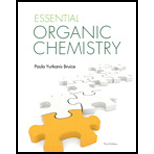
Concept explainers
(a)
Interpretation:
The representation of the given structure has to be identified as identical compounds or pair of enantiomers.
Concept introduction:
The pair of Enantiomers has different configurations.
Enantiomers are named by following Cahn-Ingold-Prelog system, in which R or S letter is used to differentiate between enantiomers.
According to Cahn-Ingold-Prelog system,
The group attached to asymmetric center should be ranked based on the
Check the direction of arrow drawn in the direction of decreasing priority. If the arrow points clockwise direction, then the compound has R configuration. If the arrow points counterclockwise direction, then the compound has S configuration. If the group with lowest priority is not bonded by a hatched wedge, then interchange this group (lowest priority) by group bonded to hatched wedge and draw the arrow in priority order but the configuration is assigned as just reverse.
(b)
Interpretation:
The representation of the given structure has to be identified as identical compounds or pair of enantiomers.
Concept introduction:
The pair of Enantiomers has different configurations.
Enantiomers are named by following Cahn-Ingold-Prelog system, in which R or S letter is used to differentiate between enantiomers.
According to Cahn-Ingold-Prelog system,
The group attached to asymmetric center should be ranked based on the atomic number of atom which directly connected to asymmetric center. The higher the atomic number of atom, higher the priority. If there is tie, then consider the next atoms attached to the connected atom and so on.
Check the direction of arrow drawn in the direction of decreasing priority. If the arrow points clockwise direction, then the compound has R configuration. If the arrow points counterclockwise direction, then the compound has S configuration. If the group with lowest priority is not bonded by a hatched wedge, then interchange this group (lowest priority) by group bonded to hatched wedge and draw the arrow in priority order but the configuration is assigned as just reverse.
(c)
Interpretation:
The representation of the given structure has to be identified as identical compounds or pair of enantiomers.
Concept introduction:
The pair of Enantiomers has different configurations.
Enantiomers are named by following Cahn-Ingold-Prelog system, in which R or S letter is used to differentiate between enantiomers.
According to Cahn-Ingold-Prelog system,
The group attached to asymmetric center should be ranked based on the atomic number of atom which directly connected to asymmetric center. The higher the atomic number of atom, higher the priority. If there is tie, then consider the next atoms attached to the connected atom and so on.
Check the direction of arrow drawn in the direction of decreasing priority. If the arrow points clockwise direction, then the compound has R configuration. If the arrow points counterclockwise direction, then the compound has S configuration. If the group with lowest priority is not bonded by a hatched wedge, then interchange this group (lowest priority) by group bonded to hatched wedge and draw the arrow in priority order but the configuration is assigned as just reverse.
Want to see the full answer?
Check out a sample textbook solution
Chapter 4 Solutions
Pearson eText for Essential Organic Chemistry -- Instant Access (Pearson+)
- Draw the two stereoisomers of the product formed in the following reaction. Are the two products enantiomers or diastereomers?arrow_forwardThe following two molecules are? H. CH3 H3C CH Br CH2OH Br The same molecule Enantiomers Constitutional Isomers Diastereomersarrow_forwarddo a pair of enantiomers share the same structural formula?arrow_forward
- 8. Identify the following sets of compounds as enantiomers, diastereomers, or identical. Relationship Between Compounds (enantiomers, diastereomers, or identical)?arrow_forwardAre these structures the same compound, enantiomers, diastereomers, or meso?arrow_forwardWhich of the following pairs of stereoisomers are related as enantiomers? a) A & B; C&D b) A& C; B&D c) A&D; B&C d) C&D; B&Carrow_forward
- Is this relationship between the pair an enantiomer or diastereomer? why?arrow_forward6) Which of the following terms best describes the pair of compounds shown: enantiomers, diastereomers, or the same compound? CH3 H- CO₂H NH₂ CO₂OH H+N³H CH3arrow_forward4. Are these two compounds: a) the same b) enantiomers OR c) diastereomers? HC- -OH Explain how you arrived at your answer. H HS — он SH Harrow_forward
- 2. Label each pair as enantiomer, diastereomer or same molecules. OCH3 HgCO OCH, CN H3C CEN and ÓCH3 H CH3 and CIarrow_forwardHow many stereogenic centers are present in the following compound? CH3CH₂CH₂CH2, H C=C H 1 02 H ||arrow_forwardClassify the structures as being either an enantiomer, diastereomer or diastereomer/epimer of D-glucose. Structure A: CH H- -OH Structure B: но- H- H- OH Structure C: H- он H- -H D-Glucose: OH || CH CH CH он H- он но -H H- он но он но но- H- но H- OH OH но -- H- -H H -Ç-H Structure A: OH Structure B: OH Structure C: OHarrow_forward

 General, Organic, and Biological ChemistryChemistryISBN:9781285853918Author:H. Stephen StokerPublisher:Cengage Learning
General, Organic, and Biological ChemistryChemistryISBN:9781285853918Author:H. Stephen StokerPublisher:Cengage Learning Organic And Biological ChemistryChemistryISBN:9781305081079Author:STOKER, H. Stephen (howard Stephen)Publisher:Cengage Learning,
Organic And Biological ChemistryChemistryISBN:9781305081079Author:STOKER, H. Stephen (howard Stephen)Publisher:Cengage Learning,


